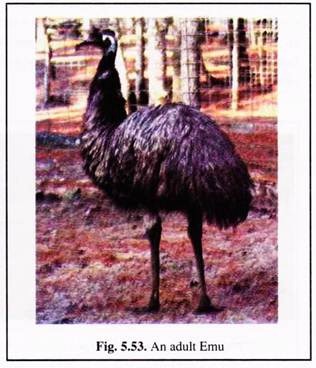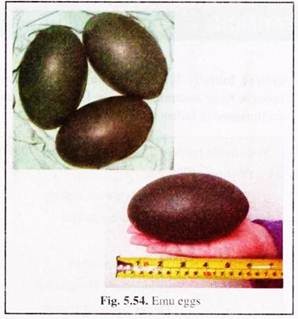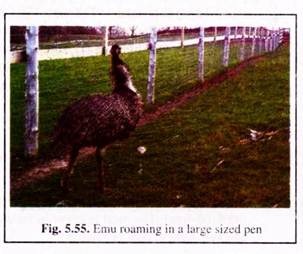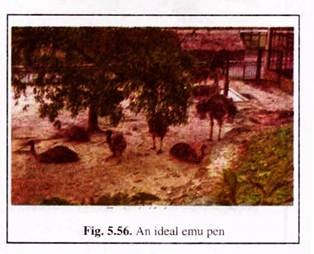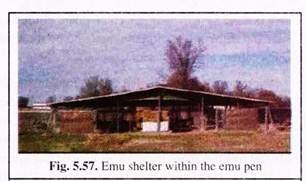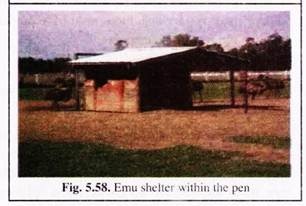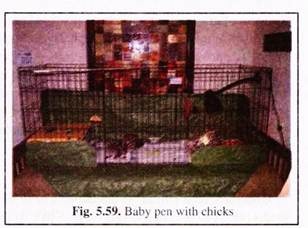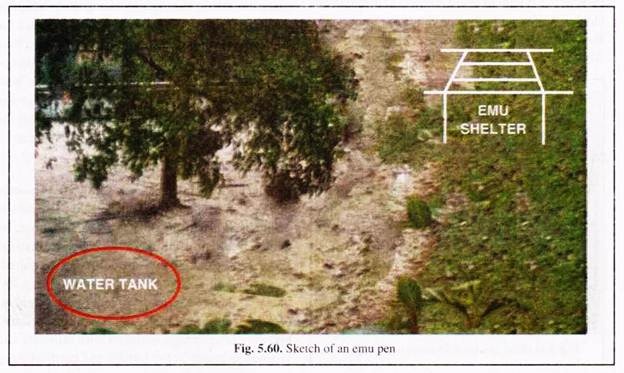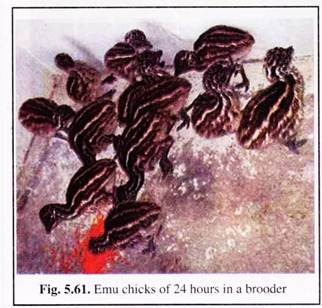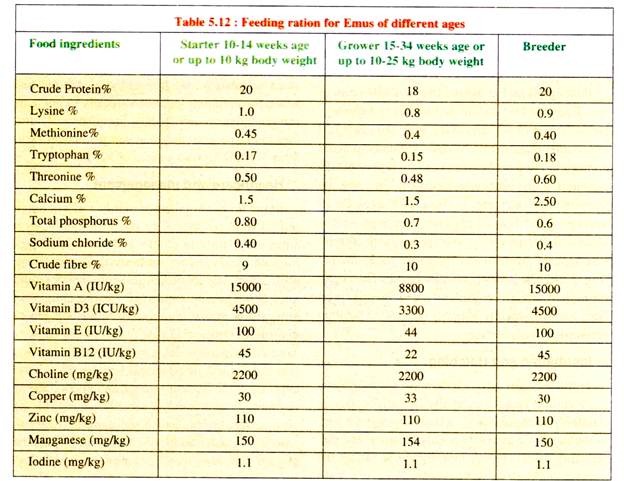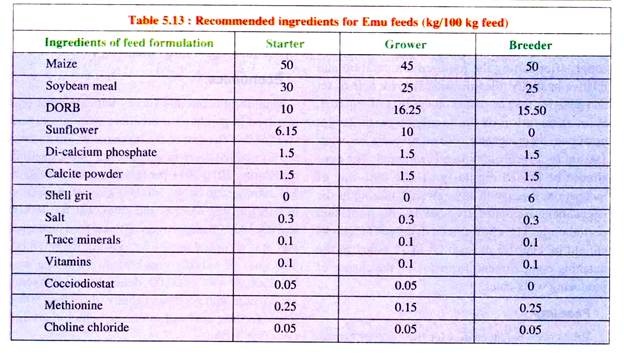In this article we will discuss about Emu:- 1. Habit and Habitat of Emu 2. Biology of Emu 3. Potentiality of Emu Culture 4. Culture Procedure 5. Economics.
Habit and Habitat of Emu:
Emus (Dromicieus sp.) belong to ratite group (flightless birds) and have high economic value for their meat, eggs, oil, skin and feathers. These birds are adaptable to varied climatic conditions. Although emu (Fig. 5.53) and ostrich were introduced in India, emu farming has gained much importance. Ratite birds have poorly developed wings and include emu, ostrich, rhea, cassowary and kiwi.
The anatomical and physiological features of these birds appear to be suitable for temperate and tropical climatic conditions. These birds can be well-maintained in extensive (ranches) and semi-intensive rearing systems with reasonably high fibrous diets. United States, Australia and China are leading countries in emu farming. Emu birds are well adapted to Indian climatic conditions.
Rajasthan University of Veterinary and Animal Sciences (RAJUVAS) in Bikaner has started emu breeding centre for providing way to subsidiary income of farmers through diversification of farming system. Initially 30 pairs of emu birds have been brought from Australia; they are being reared and acclimatised in Indian atmosphere.
ADVERTISEMENTS:
Reason for Choosing Emu for Farming:
These are second largest bird after ostrich by height and suitable for arid and semi-arid climate. They can thrive well in temperature ranging from 0°C to 50°C.
The bird is omnivorous and can easily be maintained in modified poultry feed.
Biology of Emu:
These birds reach their full size by the end of the first year. They grow up to 5.5 to 6 feet with a weight of 40 to 70 kg (Fig. 5.53). In India laying period of emu, starts after 18 to 24 months and eggs are laid during September to February.
ADVERTISEMENTS:
Eggs are dark bluish green in colour with a weight of 450 to 700 gm (Fig. 5.54). One bird can lay 20-60 eggs in a season. Incubating period is 50-52 days. The life span is 30-35 years while the productive economic life is of 20-25 years.
Potentiality of Emu Culture:
i. One boiled egg or omelet can provide for entire family.
ii. Emu meat is healthy with less cholesterol (98% fat-free). The meat is lower in fat than chicken, turkey, pork or mutton.
ADVERTISEMENTS:
iii. Good quantity of oil can be obtained from the bird. It is reported that 4-6 litres of oil devoid of any colour, taste or odour is available from this bird.
iv. The oil has penetrating properties and is effective as an analgesic, anti-allergic and antiseptic.
v. This oil is used in beauty creams and lotions, soaps, hair oils, shampoos, perfumes and massage oils.
vi. Traditionally emu oil has been used for treatment of muscle and joint pains.
Culture Procedure of Emu:
1. Emu Pen:
Emus will not survive in a small enclosure let alone kept inside a barn or roost all year round. They need wide open space to run, kick, sun bathe, and wallow in the dust (Figs. 5.55 and 5.56). Minimum requirement for a pair of emus is at least half an acre of properly fenced pen. Therefore, starting with two males and two females, one acre of land is required.
The fencing will be of wire net bordered by strong iron pipes (Fig. 5.55). The fence should not be made with ordinary wood because a single kick from the emu is enough to send a wood plank flying over few metres. The height of the fencing should be at least 8 feet. Although the emus are flightless, they can jump over a fence that is shorter than 7 feet.
2. Emu Shelter:
Within the pen there should be a small cottage with proper roofing (Figs. 5.57 and 5.58). Emus need a roof over their head and walls to protect them during adverse seasonal conditions. A pair of emus can be sheltered in 16 feet by 16 feet housing with roof high enough for good ventilation and walls that are good to protect the birds from wind chills.
There should be hay or straw to provide cushion and bedding for the emus. Emus make a pile of mess which should be cleaned every day to keep their shelter from smelling bad. They cannot be kept a day without cleaning the shelter.
3. Baby Pen:
Within the shelter a specially designed baby pen should be prepared (Fig. 5.59). The baby pen is like an iron cage with soft floor, where chicks are kept for a period of at least one month of age. The size of the cage will be 3 feet length x 2 feet breadth x 3 feet height.
The cage will be placed on the table of 3 feet height and in well-ventilated place. It should be regularly cleaned. It is advisable to keep the baby pen out of reach of the adults.
4. Laying of Emu Eggs:
Breeder ration with sufficient calcium (2.7%) for ensuring proper calcification of egg with strength should be fed. Feeding excess calcium to the breeding bird before laying will upset egg production and it also impairs fertility in male. Extra calcium in the form of grit or calcite powder is provided to the birds by placing it in a separate trough.
Eggs should be collected frequently from the pen. If eggs are soiled, it is cleaned with sand paper and mopped up with cotton. Eggs should be stored in a cooler room with a temperature of 20°C. Eggs should not be stored for more than 10 days so as to ensure better hatchability.
5. Management of Chicks:
Generally emu chicks weigh about 370 to 450 grams (about 67% of egg weight) (Fig. 5.61). At the onset (48-72 hours) of their life, emu chicks are kept in incubator for quick absorption of the yolk and proper drying.
During this period the brooding shed should be cleaned and disinfected thoroughly for receiving chicks. The floor will be covered with litter (paddy husk) and then new gunny bags or burlap will be laid over the litter.
In a brooder about 25-40 chicks may be kept to provide 4 sq. ft per chick, for the first 3 weeks. For successful brooding, a temperature of 32°C is provided for the first 10 days followed by 25°C for 3-4 weeks. Sufficient water mugs of one litre capacity and equal number of feeder troughs should be provided in the brooder. A chick guard must be 2.5 ft high to avoid jumping and straying of chicks.
A 40 watt bulb should burn in the brooder shed throughout the day for every 100 sq. ft area. After 3 weeks of age, slow extension of the brooder area is done by widening the chick guard circle and later the chick guard circle is removed by the time chicks attain 6 weeks.
Starter mash should be fed for the first 14 weeks or till attaining standard body weight of 10 kg. Proper floor space should be ensured for the birds house, as these birds require running space for their healthy life. 30 feet run space is required; hence floor space of 40 ft x 30 ft is required for about 40 chicks, if outdoor space is provided. Floor must have proper drainage and free from dampness.
6. Grower Management:
As emu chicks grow, they require bigger size waterers and feeders and increased floor space.
Different sexes should be reared separately. If necessary, sufficient paddy husk should be added in the pen to manage the litter in good and dry condition. Birds are well-fed on grower mash till they attain 34 weeks age or 25 kg body weight. Greens should comprise, about 10% of diet particularly different kinds of leaf meals, for making the birds adapted to fibrous diets.
Sufficient amount of clean water is provided at the time of feeding. Ensured dry litter condition throughout the grower stage is recommended. Provision of 40 ft x 100 ft space for 40 birds in outdoor space is recommended.
Floor must be easily drained and should be void of dampness. At the time of capturing, it is required to hold the adult birds firmly by grabbing both the wings and preventing them from kicking. It is essential that the birds are not harmed during the period of capture.
7. Breeder Management:
Emu birds attain sexual maturity by 18-24 months of age. In a pen, a sex ratio of 1 male: 1 female is maintained. In case of pen mating, pairing should be done based on the compatibility. During mating, about 2500 sq. ft floor space per pair, is required.
Trees and shrubs may be provided for privacy and inducing them for mating. Breeder diet should be offered well in advance, i.e., 3-4 weeks prior to breeding programme, enriched with minerals and vitamins to ensure better fertility and hatchability in birds. Normally, adult bird consumes 1 kg feed /day. But during breeding season, feed intake will be drastically reduced. Hence intake of nutrients must be ensured.
First egg is laid at around two and half years of age. Eggs are laid during September to February, particularly in cooler days of the year. The egg is laid in evening. Eggs should be collected daily to avoid damage in the pen. Normally, a hen lays about 15 eggs during first year cycle. In subsequent years, the egg production increases to about 30-40 eggs.
On an average, a hen lays 25 eggs per year. Egg weighs about 450-700 gm with an average weight of 560 gm. Egg appears greenish and looks like tough marble (Fig. 5.54). The intensity of colour varies from light, medium to dark green. The surface of the egg varies from rough to smooth. Majority of eggs are medium green with rough surface.
8. Incubation and Hatching:
Fertilised eggs after adjusting to room temperature should be kept carefully in horizontally or slantingly arranged rows in a tray. The eggs are kept in the incubator after thoroughly cleaning and disinfecting them. The machine should be set for the correct incubating temperature, i.e., dry bulb temperature of about 35°C-36°C and wet bulb temperature of about 25°C-28°C (about 30-40% RH).
Eggs are then carefully placed on the tray in a setter, after setting the required temperature and relative humidity. Identification slip, for date of set and pedigree may be pasted on the eggs, if required. Prior fumigation of the incubator with 20 gm potassium permanganate + 40 ml formalin for every 100 cu. ft of incubator space is essential.
The eggs should be turned regularly till the 48th day of incubation. From 49th day onwards, turning of the eggs should be stopped. By 52nd day, the incubation period ends. The chicks need drying. The chicks should be kept for at least 24 to 72 hours in the hatching compartment, for reducing the chance of producing weak chicks.
9. Feeding:
Emus need balanced diet for their proper growth and reproduction. Based on the literature, certain nutrient requirements for different age groups are given in (Table 5.12). Feed can be prepared by using common poultry feed ingredients (Table 5.13).
Feed alone accounts for 60-70% of the production cost, hence cheap rations will economically improve the margin of returns over feeding. In commercial farms, feed intake per emu breeding pair per annum varies from 394-632 kg with a mean of 527 kg.
10. Healthcare and Management:
Ratite birds are generally sturdy and live longer (80% livability). Mortality and health problems in emus are mainly in chicks and juveniles. These include starvation, malnutrition, intestinal obstruction, leg abnormalities, coli and clostridial infections. The main causes being improper brooding or nutrition, stress, improper handling and genetic disorders.
Other diseases reported are rhinitis, candidiasis, salmonella, aspergillosis, coccidiosis, lice and ascarid infestations. Ivermectin is given every month to prevent external and internal worms beginning from 1 month of age. In emu, enteritis and viral eastern equine encephalomyelitis (EEE) are reported.
In India, so far few outbreaks of Ranikhet disease have been recorded based on gross lesions but are not confirmed. However, the birds vaccinated for Ranikhet disease at the age of 1 week (lasota), 4 week (lasota booster), 8, 15 and 40 weeks (by Mukteswar strain) gave better immunity
Economics of Emu:
Emu farm economic survey indicated that costs involved in purchase of breeding stock are expensive (68%). The rest of the investments are on farm (13%) and hatchery management (19%). Feeding cost during 2010-2011 per breeding pair per annum was estimated to be Rs. 3600.00.
Cost of production of hatching egg and day-old chick was Rs. 793.00 and Rs. 1232.00 respectively. Annual feed intake per pair was recorded as 524 kg, costing Rs. 3578.00. The cost of salable chick at day-old age was Rs. 2500.00 – Rs. 3000.00. Better returns from emu are possible with good hatchability (more than 80%), lower feeding cost and minimised chick mortality (less than 10%).
